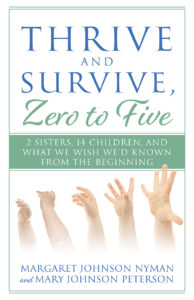Excerpt from THRIVE AND SURVIVE, ZERO TO FIVE
We learn from Scripture what patient parental teaching looks like. In Genesis 2, the Lord lets Adam, the first human being, name all the animals God had formed from the ground. These animals belonged to God. He shaped them and established their characteristics, and certainly He could have named them Himself, probably with more creativity than Adam used. But He let Adam “help” with this important task.
Verse 19 says, “He brought them to the man to see what he would name them; and whatever the man called each living creature, that was its name.” God didn’t make suggestions during the process or redo any of the names when Adam was finished. He didn’t interfere in any way. Instead He gave Adam complete freedom to do the job in whatever way he chose. And afterward, He let it stand.
This challenges today’s mothers to let their children participate in important jobs. They should give them the freedom to do it the way they believe is best, even if that way might turn out poorly. In the end, the greater value might not have been in the task accomplished but in the lessons learned along the way.
Have you ever wondered how long it took for Adam to give unique names to “all the livestock, the birds in the sky, and all the wild animals” (Genesis 2:20)? God’s patience is a wonderful model for mothers as they teach their children. The Creator had several important things for Adam to learn when He invited him to name the animals, just as you have multiple things for your children to learn in any given life experience. Patient waiting is always one of the hallmarks of a good teacher.
 SIDEBAR: CHARACTER TRAITS TO ENCOURAGE
SIDEBAR: CHARACTER TRAITS TO ENCOURAGE
- Honesty
- Kindness
- Cheerfulness
- Cooperation
- Sharing
- Patience
- Generosity
